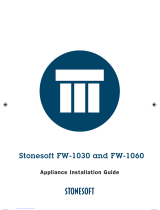
lDrill-down analysis for troubleshooting
lConsolidated and customizable reports
lTrend analysis
lPerformance monitoring
lImmediate notification of security breaches
Users deploying a Data Store can configure a Stealthwatch Management Console 2210
with a 10Gbps SFP+ DACinterface as eth0 for increased throughput. Users not
deploying a Data Store can only configure the 100Mbps/1 Gbps/10 Gbps copper
interface as eth0.
Stealthwatch Flow Collector 4210 and 5210
The Stealthwatch Flow Collector gathers NetFlow, cFlow, J-Flow, Packeteer 2,
NetStream, and IPFIX data to provide behavior-based network protection.
The Flow Collector aggregates high-speed network behavior data from multiple
networks or network segments to deliver end-to-end protection and improve
performance across geographically dispersed networks.
Users deploying a Data Store can configure a Flow Collector 4210 with a 10Gbps SFP+
DACinterface as eth0 for increased throughput. Users not deploying a Data Store can
only configure the 100Mbps/1 Gbps/10 Gbps copper interface as eth0.
As the Flow Collector receives data, it identifies known or unknown attacks,
internal misuse, and misconfigured network devices, regardless of packet
encryption or fragmentation. Once Stealthwatch identifies the behavior, the
system can take any action you have configured, if any, for that kind of
behavior.
Stealthwatch Data Store 6200
The Stealthwatch Data Store provides a central repository to store your network's
telemetry, collected by your Stealthwatch Flow Collectors. The Data Store is comprised
of a cluster of Data Nodes, each containing a portion of your data, and a backup of a
separate Data Node's data. Because all of your data is in one centralized database, as
opposed to spread across multiple Flow Collectors, your Stealthwatch Management
Console can retrieve query results from the Data Store more quickly than if it queried all
of your Flow Collectors separately. The Data Store cluster provides improved fault
tolerance, improved query response, and quicker graph and chart population.
© 2020 Cisco Systems, Inc. and/or its affiliates. All rights reserved. - 7 -
Pre-Configuration Considerations




















